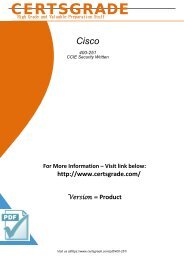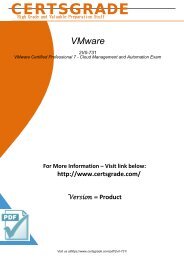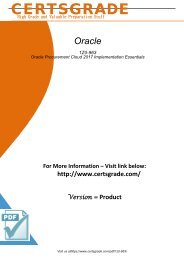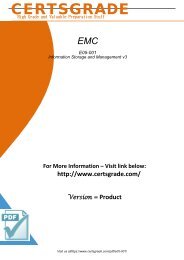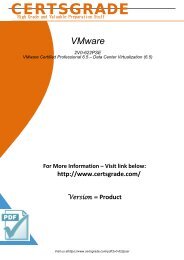70-744 Training kit
We offer you free sample questions along answers prepared by the professionals of the IT field. You can easily pass your 70-744 Test with our Training Kits. For more info please visit here: http://www.certsgrade.com/pdf/70-744/
We offer you free sample questions along answers prepared by the professionals of the IT field. You can easily pass your 70-744 Test with our Training Kits. For more info please visit here: http://www.certsgrade.com/pdf/70-744/
You also want an ePaper? Increase the reach of your titles
YUMPU automatically turns print PDFs into web optimized ePapers that Google loves.
CERTSGRADE<br />
High Grade and Valuable Preparation Stuff<br />
Microsoft<br />
<strong>70</strong>-<strong>744</strong><br />
Securing Windows Server 2016<br />
For More Information – Visit link below:<br />
http://www.certsgrade.com/<br />
Version = Product<br />
Visit us athttps://www.certsgrade.com/pdf/<strong>70</strong>-<strong>744</strong>/
Question: 1<br />
Note: The question is part of a series of questions th« present the same scenario. Each question In the<br />
series contains a unique solution that might meet the stated goals. Some question sets might have more<br />
than one correct solution, while others might not have a correct solution.<br />
After you answer a question in this section, you will NOT be able to return to It. As a result, these<br />
questions will not appear in the review screen.<br />
Your network contains an Active Directory forest named contoso.com. All servers run Windows Server<br />
2016. The forest contains 2,000 client computers that run Windows 10. All client computers are<br />
deployed from a customized Windows image.<br />
You need to deploy 10 Privileged Access Workstations (PAWs). The solution must ensure that<br />
administrators can access several client applications used by all users.<br />
Solution: You deploy 10 physical computers and configure them as PAWs. You deploy 10 additional<br />
computers and configure them by using the customized Windows image.<br />
Does this meet the goal?<br />
A. Yes<br />
B. No<br />
Question: 2<br />
Answer: A<br />
Note: This question is part of a series of questions that present the same scenario. Each question In the<br />
series contains a unique solution that might meet the stated goals. Some question sets might have more<br />
than one correct solution, while others might not have a correct solution.<br />
After you answer a question in this section, you will NOT be able to return to It. As a result, these<br />
questions will not appear in the review screen.<br />
Your network contains an Active Directory forest named contoso.com. All servers run Windows Server<br />
2016. The forest contains 2#W client computers that run Windows 10. All client computers are deployed<br />
(rom a customized Windows image.<br />
You need to deploy 10 Privileged Access Workstations (PAWs). The solution must ensure that<br />
administrators can access several client applications used by all users.<br />
Solution: You deploy 10 physical computers and configure each will as a virtualization host. You deploy<br />
the operating system on each host by using the customized Windows image. On each host you create a<br />
guest virtual machine and configure the virtual machine as a PAW.<br />
Does this meet the goal?<br />
A. Yes<br />
B. No<br />
Answer: B<br />
Visit us athttps://www.certsgrade.com/pdf/<strong>70</strong>-<strong>744</strong>/
Question: 3<br />
Note: This question is part of a series of questions that present the same scenario. Each question in the<br />
series contains a unique solution that might meet the stated goals. Some question sets might have more<br />
than one correct solution, while others might not have a correct solution.<br />
After you answer a question in this section, you will NOT be able to return to it. As a result, these<br />
questions will not appear in the review screen.<br />
Your network contains an Active Directory forest named contoso.com. All servers run Windows Server<br />
2016. The forest contains 2,000 client computers that run Windows 10. All client computers are<br />
deployed from a customized Windows image.<br />
You need to deploy 10 Privileged Access Workstations (PAWs). The solution must ensure that<br />
administrators can access several client applications used by all users.<br />
Solution: You deploy one physical computer and configure it as a Hyper-V host that runs Windows<br />
Server 2016. You create 10 virtual machines and configure each one as a PAW.<br />
Does this meet the goal?<br />
A. Yes<br />
B. No<br />
Question: 4<br />
Answer: A<br />
Note: This question is part of a series of questions that present the same scenario. Each question In the<br />
series contains a unique solution that might meet the stated goals. Some question sets might have more<br />
than one correct solution, while others might not have a correct solution.<br />
After you answer a question In this section, you will NOT be able to return to It. As a result, these<br />
questions will not appear in the review screen.<br />
Your network contains an Active Directory domain named contoso.com. The domain contains a<br />
computer named Computer1 that runs Windows 10. Computer1 connects to a home network and a<br />
corporate network.<br />
The corporate network uses the 172.16.0.0/24 address space internally.<br />
Computer1 runs an application named App1 that listens to port 8080.<br />
You need to prevent connections to App1 when Computer1 is connected to the home network.<br />
Solution: From Group Policy Management, You create an Applocker rule.<br />
A. Yes<br />
B. No<br />
Answer: B<br />
Explanation:<br />
AppLocker does not filter incoming network traffic, what you actually need is Windows Firewall Inbound<br />
Rule on the Private profile.<br />
Visit us athttps://www.certsgrade.com/pdf/<strong>70</strong>-<strong>744</strong>/
Question: 5<br />
Note: This question It part of a series of questions that present the same scenario. Each question In the<br />
series contains a unique solution that might meet the stated goats. Some question sets might have more<br />
than one correct solution, while others might not have a correct solution.<br />
After you answer a question in this section, you will NOT be able to return to It. As a result, these<br />
questions will not appear in the review screen.<br />
Your network contains an Active Directory domain named contoso.com. The domain contains a<br />
computer named Computer1 that runs Windows 10. Computer1 connects to a home network and a<br />
corporate network.<br />
The corporate network uses the 17216.0.0/24 address space internally.<br />
Computer1 runs an application named App1 that listens to port 8080.<br />
You need to prevent connections to App1 when Computer1 is connected to the home network.<br />
Solution: From Group Policy Management you create a software restriction policy.<br />
Does this meet the goal?<br />
A. Yes<br />
B. No<br />
Answer: B<br />
Explanation:<br />
Software Restriction Policy does not filter incoming network traffic, what you actually need is Windows<br />
Firewall Inbound Rule on the Private profile<br />
Question: 6<br />
Note: This question is part of a series of questions that present the same scenario. Each question in the<br />
series contains a unique solution that might meet the stated goals. Some question sets might have more<br />
than one correct solution, while others might not have a correct solution.<br />
After you answer a question In this section, you will NOT be able to return to It. As a result, these<br />
questions will not appear in the review screen.<br />
Your network contains an Active Directory domain named contoso.com. The domain contains a<br />
computer named Computer1 that runs Windows 10. Computer1 connects to a home network and a<br />
corporate network.<br />
The corporate network uses the 172.16.0.0/24 address space internally.<br />
Computer1 runs an application named App1 that listens to port 8080.<br />
You need to prevent connections to App1 when Computer1 is connected to the home network.<br />
Solution: From Windows Firewall in the Control Panel, you add an application and allow the application<br />
to communicate through the firewall on a Private network.<br />
Does this meet the goal?<br />
A. Yes<br />
Visit us athttps://www.certsgrade.com/pdf/<strong>70</strong>-<strong>744</strong>/
B. No<br />
Answer: B<br />
Question: 7<br />
Note: This question is part of a series of questions that present the same scenario. Each question in the<br />
series contains a unique solution that might meet the stated goals. Some question sets might have more<br />
than one correct solution, while others might not have a correct solution.<br />
After you answer a question in this section, you will NOT be able to return to It. As a result, these<br />
questions will not appear in the review screen.<br />
Your network contains an Active Directory domain named contoso.com. All servers run Windows Server<br />
2016. All client computers run Windows 10.<br />
The relevant objects in the domain are configured as shown in the following table.<br />
You need to assign User1 the right to restore files and folders on Server1 and Server2.<br />
Solution: You create a Group Policy object (GPO), you link the GPO to the Servers OU, and then you<br />
modify the Users Rights Assignment in the GPO.<br />
Does this meet the goat?<br />
A. Yes<br />
B. No<br />
Question: 8<br />
Answer: A<br />
Note: This question is part of a series of questions that present the same scenario. Each question in the<br />
series contains a unique solution that might meet the stated goals. Some question sets might have more<br />
than one correct solution, while others might not have a correct solution.<br />
After you answer a question in this section, you will NOT be able to return to it. As a result, these<br />
questions will not appear in the review screen.<br />
Your network contains an Active Directory domain named contoso.com. All servers run Windows Server<br />
2016. All client computers run Windows 10.<br />
The relevant objects in the domain are configured as shown in the following table.<br />
Visit us athttps://www.certsgrade.com/pdf/<strong>70</strong>-<strong>744</strong>/
You need to assign User1 the right to restore files and folders on Server1, and Server2.<br />
Solution: You add User1 to the Backup Operators group in contoso.com.<br />
Does this meet the goal?<br />
A. Yes<br />
B. No<br />
Answer: B<br />
Explanation:<br />
No, Server1 and Server2 uses local group “Backup Operators” for granting backup and restore rights to<br />
normal<br />
users.<br />
The solution would let User1 to backup files and folders on domain controllers for contoso.com instead.<br />
Question: 9<br />
Note: This question b part of a series of questions that present the same scenario. Each question In the<br />
series contains a unique solution that might meet the stated goals. Some question sets might have more<br />
than one correct solution, while others might not have a correct solution.<br />
After you answer a question in this section, you will NOT be able to return to it. As a result, these<br />
questions will not appear In the review screen.<br />
Your network contains an Active Directory domain named contow.com. All servers run Windows Server<br />
2016. All client computers run Windows 10.<br />
The relevant objects in the domain are configured as shown in the following table.<br />
You need to assign User1 the right to restore files and folders on Server1 and Server2.<br />
Solution: You create a Group Policy object (GPO), link it to the Operations Users OU, and modify the<br />
Users Rights Assignment in the GPO.<br />
Does this meet the goal?<br />
A. Yes<br />
B. No<br />
Answer: A<br />
Explanation:<br />
Yes, in “User Rights Assignment” section of a GPO, two settings for assigning backup and restore user<br />
rights<br />
are available as follow:<br />
Visit us athttps://www.certsgrade.com/pdf/<strong>70</strong>-<strong>744</strong>/
Question: 10<br />
Note: This question is part of a series of questions that present the same scenario. Each question In the<br />
series contains a unique solution that might meet the stated goals. Some question sets might have more<br />
than one correct solution, while others might not have a correct solution.<br />
After you answer a question In this section, you will NOT be able to return to It. As a result, these<br />
questions will not appear In the review screen.<br />
Your network contains an Active Directory domain named contoso.com. The domain contains multiple<br />
Hyper-V hosts.<br />
You need to deploy several critical line-of-business applications to the network; to meet the following<br />
requirements:<br />
*The resources of the applications must be isolated from the physical host.<br />
*Each application must be prevented from accessing the resources of the other applications.<br />
*The configurations of the applications must be accessible only from the operating system that hosts<br />
the application.<br />
Solution: You deploy a separate Windows container for each application.<br />
Does this meet the goal?<br />
A. Yes<br />
B. No<br />
Answer: A<br />
Explanation:<br />
By using Windows Container<br />
-The resources of the applications must be isolated from the physical host (ACHIEVED, as a single<br />
container<br />
Visit us athttps://www.certsgrade.com/pdf/<strong>70</strong>-<strong>744</strong>/
could only access its own resources, but not others)<br />
-Each application must be prevented from accessing the resources of the other applications. (ACHIEVED,<br />
as a<br />
single container could only access its own<br />
resources, but not others)<br />
-The configurations of the applications must be accessible only from the operating system that hosts the<br />
application. (ACHIEVED, you can use DockerFile or<br />
DockerRun to push configurations to containers from the Container Host OS)<br />
Question: 11<br />
Note: This question Is part of a series of questions that present the same scenario. Each question In the<br />
series contains a unique solution that might meet the stated goals. Some question sets might have more<br />
than one correct solution, while others might not have a correct solution.<br />
After you answer a question in this section, you will NOT be able to return to It, As a result, these<br />
questions will not appear in the review screen.<br />
Your network contains an Active Directory domain named contoso.com. The domain contains multiple<br />
Hyper-V hosts.<br />
You need to deploy several critical line-to-business applications to the network to meet the following<br />
requirements:<br />
*The resources of the applications must be isolated (rom the physical host.<br />
*Each application must be prevented from accessing the resources of the other applications.<br />
*The configurations of the applications must be accessible only from the operating system that hosts<br />
the application.<br />
Solution: You deploy a separate Hyper-V container for each application.<br />
Does this meet the goal?<br />
A. Yes<br />
B. No<br />
Answer: A<br />
Explanation:<br />
-The resources of the applications must be isolated from the physical host (ACHIEVED)<br />
-Each application must be prevented from accessing the resources of the other applications. (ACHIEVED)<br />
-The configurations of the applications must be accessible only from the operating system that hosts the<br />
application. (ACHIEVED)<br />
Question: 12<br />
Note: Thb question Is part of a series of questions that present the same scenario. Each question In the<br />
series contains a unique solution that might meet the stated goals. Some question sets might have more<br />
than one correct solution, while others might not have a correct solution.<br />
Visit us athttps://www.certsgrade.com/pdf/<strong>70</strong>-<strong>744</strong>/
After you answer a question in this section, you willNOTbeabletorrturntoit.Asa result, these questions<br />
will not appear in the review screen.<br />
Your network contains an Active Directory domain named contoso.com. The domain contains multiple<br />
Hyper-V hosts.<br />
You need to deploy several critical line-of-business applications to the network to meet the following<br />
requirements:<br />
*The resources of the applications must be isolated from the physical host<br />
*Each application must be prevented from accessing the resources of the other applications.<br />
*The configurations of the applications must be accessible only from the operating system that hosts<br />
the application.<br />
Solution: You deploy one Windows container to host all of the applications.<br />
Does this meet the goal?<br />
A. Yes<br />
B. No<br />
Question: 13<br />
Answer: A<br />
Your network contains an Active Directory domain named contoso.com. The domain contains 1,000<br />
client computers that run Windows 10.<br />
A security audit reveals that the network recently experienced a Pass-the-Hash attack. The attack was<br />
initiated from a client computer and accessed Active Directory objects restricted to the members of the<br />
Domain Admins group.<br />
You need to minimize the impact of another successful Pass-the-Hash attack on the domain.<br />
What should you recommend?<br />
A. Instruct all users to sign in to a client computer by using a Microsoft account.<br />
B. Move the computer accounts of all the client computers to a new organizational unit (OU). Remove<br />
the permissions to the new OU from the Domain Admins group.<br />
C. Instruct all administrators to use a local Administrators account when they sign in to a client<br />
computer.<br />
D. Move the computer accounts of the domain controllers to a new organizational unit (OU). Remove<br />
the permissions to the new OU from the Domain Admins group.<br />
Answer: C<br />
Explanation:<br />
https://docs.microsoft.com/en-us/windows/access-protection/remote-credential-guard<br />
Visit us athttps://www.certsgrade.com/pdf/<strong>70</strong>-<strong>744</strong>/
Question: 14<br />
Your network contains an Active Directory forest named contoso.com. The forest functional level is<br />
Windows Server 2012. All servers run Windows Server 2016.<br />
You create a new bastion forest named admin.contoso.com. The forest functional level of<br />
admin.contoso.com is Windows Server 2012 R2.<br />
You need to implement a Privileged Access Management (PAM) solution.<br />
Which two actions should you perform? Each correct answer presents part of the solution.<br />
A. Raise the forest functional level of admm.contoso.com.<br />
B. Deploy Microsoft Identify Management (MIM) 2016 to admin.contoso.com.<br />
Visit us athttps://www.certsgrade.com/pdf/<strong>70</strong>-<strong>744</strong>/
C. Configure contoso.com to trust admin.contoso.com.<br />
D. Deploy Microsoft Identity Management (MIM) 2016 to contoso.com.<br />
E. Raise the forest functional level of contoso.com.<br />
F. Configure admin.contoso.com to trust contoso.com.<br />
Answer: DE<br />
Explanation:<br />
https://docs.microsoft.com/en-us/microsoft-identity-manager/pam/deploy-pam-with-windows-server-<br />
2016<br />
https://docs.microsoft.com/en-us/windows-server/identity/ad-ds/windows-server-2016-functionallevels<br />
For the bastion forest which deploys MIM, you should raise the Forest Functional Level to “Windows<br />
Server<br />
2016″<br />
Question: 15<br />
Your network contains an Active Directory domain named contoso.com. The domain contains two<br />
servers named Server1 and Server2 that run Windows Server 2016.<br />
Server1 is configured as a domain controller.<br />
You configure Server1 as a Just Enough Administration (JEA) endpoint You configure the required JEA<br />
rights for a user named User1.<br />
You need to tell User1 how to manage Active Directory objects from Server2.<br />
What should you tell User1 to do first on Server2?<br />
A. From a command prompt, run ntdsutil.exe.<br />
B. From Windows PowerShell, run the Import-Module cmdlet.<br />
C. From Windows PowerShell run the Enter-PSSession cmdlet.<br />
D. Install the management consoles for Active Directory, and then launch Active Directory Users and<br />
Computer.<br />
Answer: C<br />
Visit us athttps://www.certsgrade.com/pdf/<strong>70</strong>-<strong>744</strong>/
Powered by TCPDF (www.tcpdf.org)<br />
For More Information – Visit link below:<br />
http://www.certsgrade.com/<br />
PRODUCT FEATURES<br />
100% Money Back Guarantee<br />
90 Days Free updates<br />
Special Discounts on Bulk Orders<br />
Guaranteed Success<br />
50,000 Satisfied Customers<br />
100% Secure Shopping<br />
Privacy Policy<br />
Refund Policy<br />
WE ACCEPT<br />
Visit us athttps://www.certsgrade.com/pdf/<strong>70</strong>-<strong>744</strong>/





